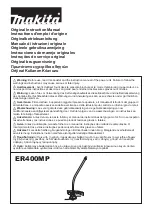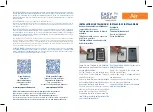
Wireless Rain Sensor Wiring
Important! Before connecting wires, you must determine whether your controller uses
“Normally Open” or “Normally Closed” wiring for sensors.
All Rain Bird controllers, and most other manufacturers’ controllers, are installed using a
“Normally Closed” wiring method.
Wiring Instructions
Note: Before beginning, determine whether the controller uses “Normally Open” or
“Normally Closed” wiring.
Normally Closed Installations
Rain Bird ESP-MC Controller
– FIG. 1 (The Rain Bird ESP-MC Controller has only one 24VAC
terminal)
1. Connect the Red lead to the 24VAC terminal.
2. Connect the Black lead to the sensor
terminal (“Sensor” or “SN”) next to the
24VAC terminal.
3. Connect the Brown lead to the same terminal
as the Black wire.
4. Connect the Green lead to the sensor
terminal next to the common terminal.
Note: White lead labeled “NO” is only used for “Normally Open” configurations, and is
not used here.
Controllers With Sensor Input
– FIG. 2 (Rain Bird ESP-LX+, Rain Bird ESP Modular, Most
Other Controllers)
1. Connect the Red and Black leads to the two
24VAC terminals.
2. Remove jumper wire (if present).
3. Connect Green lead and Brown lead to the
sensor terminals.
Note: White lead labeled “NO” is only used
for “Normally Open” configurations, and is
not used here. Also, make sure the sensor
activation switch on the controller is set to
the desired on/off position.
Controllers Without Sensor Input
– FIG. 3
1. Connect Red and Black leads to the two
24VAC terminals.
2. Disconnect the valve common wire from the
common terminal (“C” or “COM”).
3. Connect the Green lead to the controller
common terminal.
4. Connect the Brown lead to the valve
common.
Note: White lead labeled “NO” is only used for “Normally Open” configurations, and is
not used here.
WRS Wireless Rain Sensor
2
Wireless Rain Sensor
The Wireless Rain Sensor Family, consisting of the Wireless Rain Sensor and Wireless
Rain/Freeze Sensor, automatically monitors rainfall and freezing conditions and shuts off your
sprinklers to prevent unnecessary watering.
Note:
The Wireless Rain Sensor is a low-voltage device compatible with all 24 volt
alternating current (VAC) control circuits and 24 VAC pump start relays.
The Wireless Rain Sensor is a very sophisticated Sensor Transmitter and Receiver
system designed to work with all 24 volt alternating current (VAC) control circuits
and 24 VAC pump start relay circuits. The Receiver has three Light Emitting Diodes
(LEDs). Each LED can indicate two conditions. If the LED is solid then the condition
labeled on the left is occurring. If the LED is blinking the condition labeled on the
right has taken place. These are explained on page 10.
1. Installation
Note:
Follow the installation instructions carefully and install the unit only in full compliance
with the National Electrical Code (NEC) or your local electrical code.
There are two components of the Wireless Rain Sensor product, the Sensor Transmitter and
the Receiver.
Important!:
Begin by installing the Receiver and test the two components (transmitter and
receiver) side by side before mounting the Sensor Transmitter.
Wireless Rain Sensor Receiver Mounting
1. Select a place near your controller where you will install the Receiver. Ensure that there
will be room for the receiver antenna and that the leads will reach to the sensor
connection on your controller (approximately 24 inches).
Note:
The Receiver unit is weather resistant and is suitable for mounting near an outdoor
controller.
2. Secure the bracket to the wall near your controller with appropriate fasteners. Be sure to
install the bracket with the flanges facing out away from the wall.
See Illustration 1.
3. Slide the water resistant receiver unit down onto the mounting bracket.
See Illustration 2.
4. Attach the red “Notice” sticker to your automated irrigation system control panel.
5. Attach the gray “Receiver” memory sticker to the side of the Receiver.
1
WRS Wireless Rain Sensor
1
Mount Receiver
bracket near
existing
controller.
2
Slide Receiver
down on to the
mounting
bracket.
Receiver
Memory
Record
Install bracket
with flanges
facing out
from the wall.
FIGURE 1 - Rain Bird ESP-MC Controller
FIGURE 2 - Controllers WITH Sensor Input
FIGURE 3 - Controllers WITHOUT Sensor Input

























